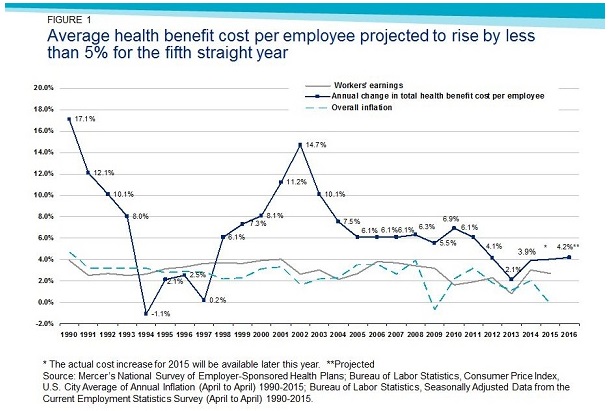Employee Benefit Costs on a “Winning Streak”?
Mercer, a leading firm of consulting actuaries, tells us that the cost of employee benefits in 2016 will grow slowly – a “winning streak”:
Early responses from a major Mercer survey still in the field show employers predicting that health benefit cost per employee will rise by 4.2% on average in 2016 (see Fig. 1) after they make planned changes such as raising deductibles or switching carriers.
A closer look indicates no real reduction in the rate of cost growth of employee benefits.
One way employers have kept cost growth low is to increase deductibles. We call this “consumer-driven health care” because when employees control a larger share of health dollars directly they consume medical care more prudently. The next step is private exchanges, which give employees a wider choice of plans. These exchanges have reduced benefit costs.
However, we still have not cracked the problem that prices are formed by health plans and providers: Patients can increasingly react to prices but they cannot participate in forming prices, like they do in normal markets.
Indeed, even without considering the increase in deductibles – which have risen seven times faster than wages over the last ten years – the real growth in cost of health benefits is a little higher than it was a decade ago. This is clear in Mercer’s Figure 1. Current inflation is zero, so the nominal cost growth of 4.2 percent is all real growth. In the mid-2000s, nominal cost growth was a 6.1 percent annually, but inflation was around 3 percent, indicating real growth of about 3 percent.
Overall, if the cost curve is bending at all, it is bending in the wrong direction.



Switching carriers is another claimed contributor. While it may lock in lower premiums for the entity switching, it says nothing about actual future costs. It is based on one carrier’s estimate compared to another carrier’s. Unless the succeeding carrier has better contract or better utilization control, and assuming no change in benefit design, the costs will be what the costs will be. Switching is temporary at best.